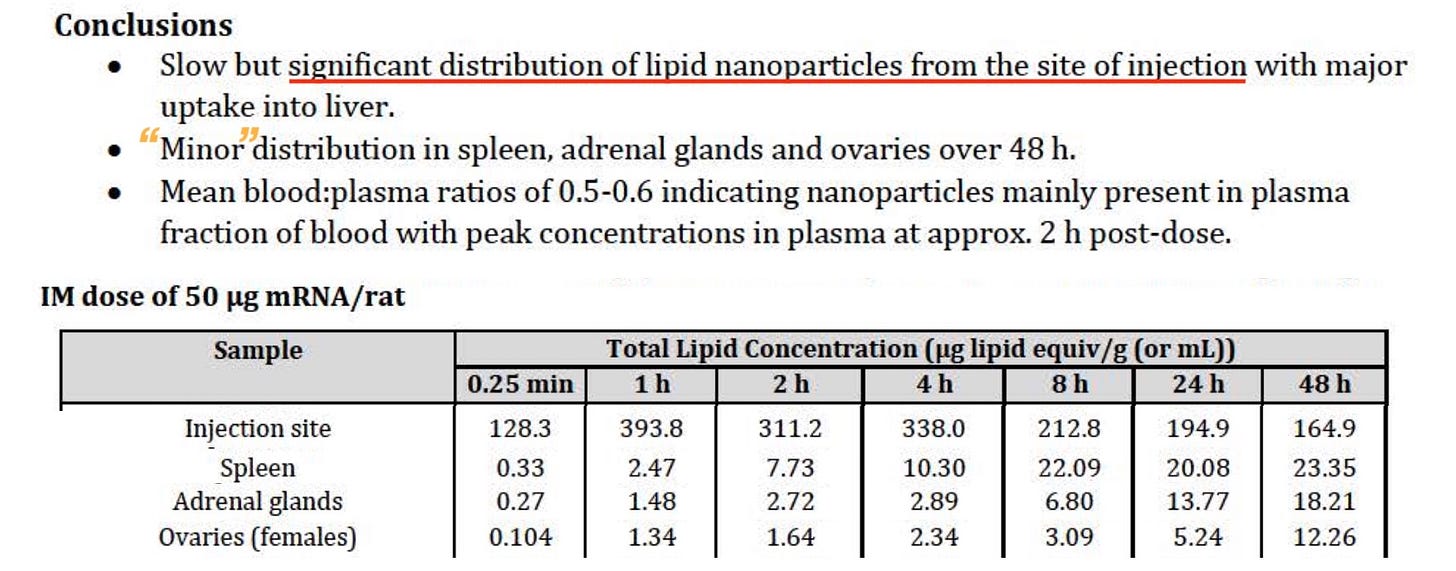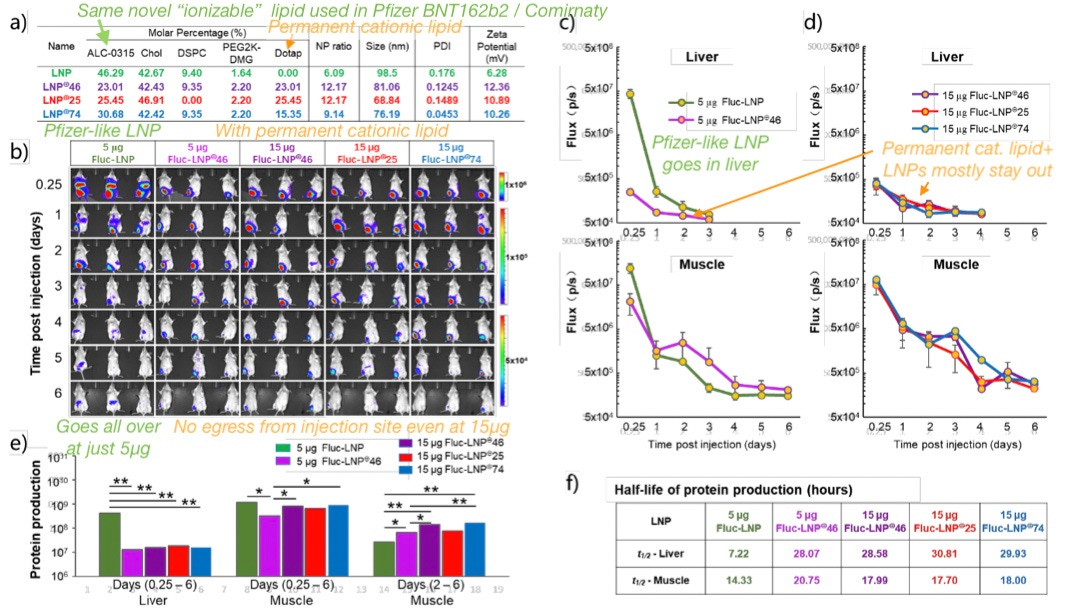Validating LNP's role in mRNA vaccine biodistribution
Not all LNPs escape injection sites alike.
Summary (click to expand):
Someone finally investigated LNP biodistribution and mentioned its role in mRNA vaccine adverse events…
…And it was a team of researchers in China.1
Background
This preprint has, coincidentally, been uploaded in the same week that Pfizer’s nonclinical biodistribution data has regained some buzz. John Campbell, for whatever reason, apparently just discovered the results; but the pdf showing Pfizer’s LNP going all over rats after being injected in muscle — foi-2389-06.pdf — has been hosted online by the Australian government for at least 18 months.2
The notorious study revealed by foi-2389-06, which has so astonished Campbell 18 months later, was named “Study 185350,” and was part of Pfizer’s bare-bones, perfunctory “nonclinical” evaluation of the product they were rushing to inject into trial subjects in 2020. Most readers are probably familiar with the table showing the results:

Oh, so there’s a “minor” bit of adrenal gland transfection after Covid vaccination — big deal.
These results were obtained using a Covid-vaccine-like LNP test system delivering luciferase (glowy protein) RNA, though with the added measure of radiolabelling the lipids themselves for tracking where LNPs were going in rats. This “vaccine-like” investigation was the best Pfizer could offer regulators, since for the actual product being pseudo-authorized around the West,
Ionizable vs. cationic
Finally, as far as background, it is helpful to clarify that the Pfizer and Moderna LNPs use what are termed “ionizable lipids.” These aren’t supposed to be positive until they enter cells inside of little vesicles and the cell tries to eat up what is inside. Many authors refer to them as “cationic,” but that term better describes lipids that are positive at a neutral PH. This is important because Peng, et al. use permanent cationic lipid-having LNPs and compare them to the (ionizable LNP-only) Covid vaccine formula.
Peng, et al.
Is a coincidentally just-uploaded pre-print affirming and refining those results, using different kinds of “Pfizer-vaccine-like” LNPs.
What Peng, et al. adds
Synthesizing a “store brand” Pfizer-like mRNA Covid vaccine in-house (using the same LNP ingredients, and RNA for luciferase), and injecting mice, they show “off-target” expression in multiple tissues, i.e. systemic expression — the LNPs are getting all over the body, just like in Pfizer’s Study 185350.
When using different lipid formulations, post-intramuscular injection expression can also be shown to be systemic, or to instead be limited to the injection site. Stay-put LNPs are the ones with permanently positive lipids, while go-all-over LNPs only have ionizable lipids (like the Pfizer and Moderna Covid vaccines).


This is an important validation of the results in Study 185350, because it not only shows that an LNP similar to the Pfizer vaccine is going all over the body, but that there is a something knowable about the LNP that causes this. The results in Study 185350 are not just a meaningless fluke, but an outcome of wrong design choices.
All of which is not to say that designing an ionizable-only LNP injection that stays put is totally impossible; however, this appears to be a strong, built-in hazard which is replicated in the specific formulation designed by Peng, et al. to resemble the Pfizer product, using the exact same ALC-0315 lipid.
Why ionizable-only causes systemic distribution
Peng, et al. posit that the ionizable-only LNP design facilitates accumulation of lipid-carrying proteins around the LNP that enable passage into blood (and from there, surrounding cells throughout the entire bloodstream), namely Apolipoprotein E. These proteins are like little taxi drivers floating around, looking for lipids who need a ride on the vascular superhighway. Permanent cationic (positive charge-having) lipids (presumably) block the taxi drivers.
Apolipoprotein E (ApoE) plays a major role in the clearance and hepatocellular uptake of physiological lipoproteins, also acts as an endogenous targeting ligand for LNPs, but not LNPs composed of cationic lipid.[…]
The surface potential of [permanently positive lipid-having] Dotap-LNPs undergoes a transformation to exhibit a weak positive charge. This change repels LNPs from conjugation with ApoE and other lipid carriers in the blood, diminishing their systemic transportation.
Does systemic biodistribution cause AEs, and are permanently positive lipid-having LNPs safe?
Peng, et al. explicitly and repeatedly voice the argument that the systemic biodistribution of the LNPs in Pfizer (and Moderna)’s mRNA vaccines is responsible for reported adverse events, based on what has been previously published.
In addition to inflammatory and reactogenic responses induced by vaccine components and impurities, molecular mimicry between the SARS-CoV-2 spike protein (CovS) and self- antigens, as well as immune disorders in susceptible individuals, systemic off-target gene expressions have been identified as primary causes of acute adverse reactions and side effects associated with nucleoside-modified mRNA vaccines3 […]
However, following intramuscular injection, a significant portion of the active ingredients may still leak into the bloodstream and [capillary-adjacent cell space] resulting in systemic delivery of mRNA-LNP and off-target expression of antigenic proteins.4 A small amount of circulating Spike protein antigen was also detected in the blood of mRNA vaccine recipients with side effects tending to occur more frequently following boost immunizations.
In mouse intramuscular injection experiments [conducted in 2015-2019], tracer genes delivered by [non-Covid-vaccine] mRNA encapsulated in LNP were primarily expressed at the injection site but also appeared in tissues such as liver, lung, brain, heart, kidney, muscle, and extremities with varying intensities.5 Systemic leakage of mRNA-LNP and off-target expression of antigenic proteins can stimulate tissue damage, neurotoxicity and activate cytokines and complement which are primary causes contributing to fever, chills, and other transient adverse events.
These are reasonable arguments. By validating systemic biodistribution with multiple ionizable-only LNP mRNA test vehicles, they have shown we can expect that almost everyone injected with the Covid vaccines had LNPs escape the injection site, regardless of whether they were spared accidental intravenous injection. For the remaining question of why adverse events would still appear to follow a Russian Roulette distribution among recipients, I refer to my proposal regarding discrepancies in full-length RNA contents per dose:
Of course, it is still possible that intravenous injection additionally promotes adverse events, either somewhat or predominantly, by accelerating or increasing the baseline process of systemic biodistribution.
Validating biodistribution-associated toxicity
Here, Peng. et al. used in-house LNPs resembling Pfizer’s, either empty or carrying imitation Pfizer vaccine RNA (with the same codon phenotype and alternate uridines), and versions of the latter with permanent cationic lipids added; presumably the cationic ones would stay put as with their tests involving luciferase RNA.
Observing markers for liver toxicity, inflammation, and leukopenia (white blood-cell depletion), it appeared their cationic-having LNP for spike was the safest, followed by the empty (ionizable-only) LNP, followed by the full imitation Pfizer LNP for spike.

Meanwhile, their positive-ified imitation Pfizer vaccines were just as good, if not a bit better, and meeting immune response benchmarks in the long run:

It therefore seems that the systemic biodistribution of Covid vaccine LNPs is responsible for some degree of their toxicity and/or adverse effects, at no benefit to their immunogenicity.
But does that mean cationic-having LNPs are truly “safe”?
It remains counter-intuitive that increasing positive charge could make LNPs safe. Even if safer, due to elimination of systemic biodistribution, these mouse-based tests should obviously not be considered sufficient for establishing that such vaccines should be used in humans. Obviously, a few thousand volunteers should be chaotically rush-injected and almost immediately unblinded before then, just like in a proper vaccine trial.
If you derived value from this post, please drop a few coins in your fact-barista’s tip jar.
Peng, X. et al. “Improving mRNA vaccine safety and efficiency with cationized lipid nanoparticle formula.” medrxiv.org
Pillay, J. et al. “Incidence, risk factors, natural history, and hypothesised mechanisms of myocarditis and pericarditis following covid-19 vaccination: living evidence syntheses and review.” BMJ. 2022 Jul 13;378:e069445.
Morais, P. Adachi, H. Yu, YT. “The Critical Contribution of Pseudouridine to mRNA COVID-19 Vaccines.” Front Cell Dev Biol. 2021 Nov 4;9:789427.
Patone, M. et al. “Neurological complications after first dose of COVID-19 vaccines and SARS-CoV-2 infection.” Nat Med. 2021 Dec;27(12):2144-2153.
Pardi, N. et al. (2015.) “Expression kinetics of nucleoside-modified mRNA delivered in lipid nanoparticles to mice by various routes.” J Control Release. 2015 Nov 10;217:345-51.
Hassett, KJ. et al. (2019.) “Optimization of Lipid Nanoparticles for Intramuscular Administration of mRNA Vaccines.” Mol Ther Nucleic Acids. 2019 Apr 15;15:1-11.












Updated with two recent adrenal cancer headlines; meant to include those to begin with.
🎯 "Obviously, a few thousand volunteers should be chaotically rush-injected and almost immediately unblinded before then, just like in a proper vaccine trial". 🤡🌍